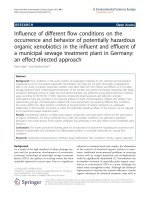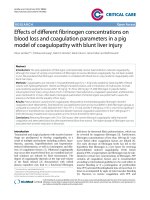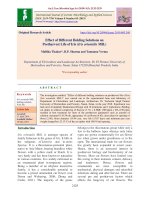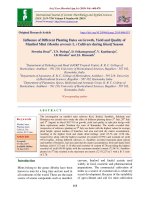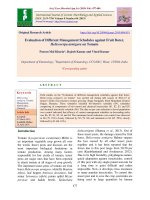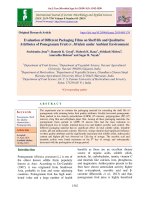Evaluation of different packaging films on shelf life and qualitative attributes of pomegranate fruit cv. Mridula under ambient environment
Bạn đang xem bản rút gọn của tài liệu. Xem và tải ngay bản đầy đủ của tài liệu tại đây (318.89 KB, 9 trang )
Int.J.Curr.Microbiol.App.Sci (2019) 8(5): 1542-1550
International Journal of Current Microbiology and Applied Sciences
ISSN: 2319-7706 Volume 8 Number 05 (2019)
Journal homepage:
Original Research Article
/>
Evaluation of Different Packaging Films on Shelf life and Qualitative
Attributes of Pomegranate Fruit cv. Mridula under Ambient Environment
Suchismita Jena1*, Ramesh K. Goyal2, Mahesh K. Rana3, Abhilash Mishra4,
Anuradha Bishnoi2 and Sagar R. Nayak5
1
Department of Fruit Science, 5Department of Vegetable Science, Navsari Agricultural
University, Navsari 396450 (Gujarat), India
2
Department of Horticulture, 3Department of Vegetable Science, Chaudhary Charan Singh
Haryana Agricultural University, Hisar 2116443 (Haryana), India
4
Department of Fruit Science, Dr. Y. S. Parmar University of Horticulture and Forestry,
Solan, 173230 (H. P.), India
*Corresponding author
ABSTRACT
Keywords
Pomegranate, Shelf
life, Quality
characteristics,
Packaging films
Article Info
Accepted:
15 April 2019
Available Online:
10 May 2019
The experiment aim to evaluate the packaging material for extending the shelf life of
pomegranate with retaining better fruit quality attributes. Freshly harvested pomegranate
fruits packed in low density polyethylene (LDPE) (25 micron), polypropylene (PP) (25
micron), cling film and cellophane paper film. Among all these packaging materials, the
pomegranate fruits packed in LDPE 25 micron film had the least reduction in
physiological loss in weight, minimal decay loss and highest ascorbic acid content. The
different packaging material had no significant effect on total soluble solids, titratable
acidity, pH and anthocyanin contents. However, storage duration had significant influence
on these quality attributes and the significantly maximum total soluble solids, anthocyanin
content and highest pH was observed on 12th day of storage. The ascorbic acid and
titratable acidity were found maximum on the 0 th day of storage and subsequently
decreased with the prolongation of storage period.
Introduction
Pomegranate ((Punica granatum L.) is one of
the oldest known edible fruits popularly
known as Anar. According to De-Candolle
(1967), it was originated from Southwest
Asia, probably in Iran and some adjoining
countries. Pomegranate fruit has high nutritional value and a large number of health
benefits as these are an excellent dietary
source of organic acids, soluble solids,
protein, fat, carbohydrates, tannin, vitamin C
and minerals like calcium, iron, phosphorus,
and magnesium. Anthocyanins present in the
fruit have shown antioxidant activity higher
than α-tocopherol, ascorbic acid and βcarotene (Bhowmik et al., 2013) and thus
pomegranate fruit juice is highly beneficial
1542
Int.J.Curr.Microbiol.App.Sci (2019) 8(5): 1542-1550
for leprosy patients. Pomegranate even being
a non-climacteric many seeded berry, it is
subjected to continuous physiological and
biochemical changes after harvest with severe
problems of quality and decay loss during
post-harvest handling and storage. The major
cause limiting the storage potential of
pomegranate is the development of decay,
which is often caused due to the presence of
fungal infection especially in blossom end of
the fruit at harvest. Several post-harvest
methods have been evaluated out of which,
the modified atmosphere packaging (MAP) is
a simple, economical and effective method for
delaying post-harvest deterioration, and
maintaining quality of pomegranate (Selcuk
and Erkan, 2016). In MAP, an atmosphere
around the fruit with low in oxygen (O2)
and/or high in carbon dioxide (CO2) is created
to influence the metabolism of the packed
produce, which can result in reduction of
respiratory activity, delaying softening,
ripening, senescence and reducing incidence
of physiological disorders and pathogenic
infestations. Most commonly packaging films
such as LDPE, PP, cling films and cellophane
paper are used to create the desired modified
atmosphere around the fruits. These
packaging materials also play significant role
in attracting the consumers and prolonging
the storage period of many fruits. In our
study, we used these different films to
evaluate their potentiality in increasing shelf
life and access the quality attributes as
influenced by the packing, to identify the best
packing film for pomegranate under ambient
conditions.
University, Hisar during 2016-17. The
individual fruits were wrapped with different
packaging films viz., low density polyethylene
(LDPE) (25 micron), polypropylene (PP) (25
micron), cling film, cellophane paper and
thereafter, wrapped fruits were kept in CFB
boxes. The boxes were stored at room
temperature with maintaining maximum
29±2°C, minimum 12±2°C and relative
humidity 90±5%. Various observations of the
stored fruits were recorded periodically at
three days interval from the inception of
storage. The loss in weight during storage was
calculated by subtracting the final weight
from the initial weight of the fruits. The decay
loss was calculated by subtracting the number
of decayed fruit from the total number of
fruits. The total soluble solids of fruits were
determined at room temperature by using
hand refractometer having a range of zero to
32 (ERMA) by putting a drop of pomegranate
juice. The refractometer was calibrated with
distilled water after every use and the values
were expressed in %. pH of freshly extracted
pomegranate fruit juice from each sample was
determined by using digital pH meter, which
was calibrated with buffer solution having
pH= 4.0 and 9.2. Acidity and ascorbic acid
were determined as per the method suggested
by AOAC (1990). The total anthocyanin
content was determined according to the pH
differential spectroscopic method (Cheng and
Breen, 1991; Tonutare et al., 2014). The data
were analyzed using completely randomized
design (CRD) and critical differences (C.D.)
at 5% level of significance with the help of a
windows based computer package OPSTAT
(Sheoran 2004).
Materials and Methods
Results and Discussion
The fresh fruits of pomegranate cv. Mridula
were procured from the Centre of Excellence
for Fruits, Mangiana (Haryana). The
experiment was carried out in Post-harvest
Technology Laboratory of the Department of
Horticulture, CCS Haryana Agricultural
Physiological loss in weight (%)
The data presented in Table 1 clearly indicate
that the different packaging materials
significantly affected the physiological loss in
1543
Int.J.Curr.Microbiol.App.Sci (2019) 8(5): 1542-1550
weight of pomegranate fruits. On the 3rd day
of storage, the fruits packed in LDPE 25
micron had recorded significantly least loss in
weight (0.38%), which was statistically at par
with fruits packed in polypropylene 25
micron (1.06%), cling film (0.84%) and
cellophane paper (1.11%). On the 6th day, the
least loss in weight was observed from fruits
packed with LDPE 25 micron (1.36%), which
was statistically at par with packaging
material polypropylene 25 micron (1.87%).
On 9th and 12th day, the fruits wrapped in
LDPE
25
micron
illustrated
least
physiological loss in weight, i.e., 4.19 and
5.17%, respectively as compared to other
packaging materials under ambient room
conditions. On 6th and 12th day, the treatment
cellophane paper and cling film and on 9th
day, the treatment polypropylene 25 micron,
cellophane paper and cling film were
statistically at par with each other.
The unwrapped fruits taken as control had the
highest physiological loss in weight, i.e., 5.12,
7.25, 10.31and 12.61% on 3rd, 6th, 9th and
12th day of storage period, respectively. The
fruits wrapped with LDPE 25 micron was
found best in reducing the physiological loss
in weight while fruits retained unwrapped
exhibited
the
highest
reduction
in
physiological loss in weight. Fruits packed in
different packaging films recorded lower
weight loss, which was obvious due to their
role in altering the CO2 and O2 concentration
inside the packages and thereby, reducing the
rate
of
transpiration/respiration
and
maintaining higher humidity inside the
wrappers (Ben, 1985). These results are in
conformity with the findings of Valero et al.,
(2006) in table grapes, Maniwara et al.,
(2015) in purple passion fruit, Kumar and
Nagpal (1996) in mango,Nielsen and Leufven
(2008) in strawberry, Siddiqui and Gupta
(1997) in guava and Sonkar and Ladaniya
(1998) in Nagpur mandarin.
Decay loss (%)
The perusal of data in Table 2 reveals that the
different packaging materials exerted
significant effect on decay loss of
pomegranate fruits. Under ambient room
conditions, no decay loss was found during
first eight days of storage of pomegranate
fruits, while the minimum decay loss of 3.71
and 10.51% was recorded on 9th and 12th day
of storage in fruits wrapped with LDPE 25
micron packaging film and the maximum
decay loss of 11.40 and 23.36% was found in
unwrapped fruits, respectively in the same
period of time. In our experiment, LDPE 25
micron was observed as the best packing
materials in terms of controlling decay loss,
where least decay loss was observed on9th and
12th days of storage. This might be due to the
property of packaging films to retain a higher
level of CO2 inside the package and might
exhibited fungi-static effect (Li and Kader,
1989). The results are in line with the findings
of Ozkaya et al., (2009) who also reported
that the modified atmosphere packaging
resulted in lower decay loss in strawberry
fruits than the control fruits.
Total soluble solids (%)
The total soluble solids as observed from
pomegranate fruits packed in different
packaging materials is represented in Table 3
and the mean data exhibited statistically
significant variation with respect to the period
of storage but the packaging films and the
interaction between packaging materials and
storage duration had showed no significant
effect on total soluble solids of fruits. Under
ambient room conditions, the minimum total
soluble solids were found on zero day
(13.37%), which was statistically at par with
TSS of 3rd day of storage (13.46%) and the
maximum TSS was found on 12th day
(14.24%) of storage. The increase in TSS
during storage period could be attributed to
1544
Int.J.Curr.Microbiol.App.Sci (2019) 8(5): 1542-1550
the water loss and hydrolysis of starch and
conversation of other polysaccharides to
soluble form of sugar (Wills et al., 1980). The
gradual increase in TSS took a longer period
of time in film wrapped fruits was possibly
due to retarded ripening and senescence
processes, which simultaneously delayed the
conversion of starch into sugars (Pongener et
al., 2011). The results of present study was
corroborate with the findings of O’Grady et
al., (2014).
Titratable acidity (%)
The analysis of variance of the titratable
acidity of stored pomegranate fruits packed
with different packaging films was presented
in Table 4 and it showed a significant
variation over the storage period. However,
no significant variation was recorded for the
effect of different packaging films and the
interaction between the packaging films with
the period of storage. The titratable acidity of
the fruits went on decreasing with the
advancement of storage period. The titratable
acidity was observed maximum on zero day
(0.43%) and minimum on 12th (0.40%) day
of storage, whereas, the titratable acidity on
6th (0.41%) and 9th day (0.41%) was found
statistically at par with each other under
ambient room conditions. Most of the
polyethylene bags retained higher acidity
content of fruits as compared to control fruits.
This might be due to the development of
modified atmospheric condition around the
fruits which might have slow down various
metabolic processes, resulting in lower
utilization of acids in respiration (Wavlah and
Athale, 1988). Variability in titratable acidity
could be attributed to the effect of increased
solubility of CO₂ inside the packages (Caleb
et al., 2013). Similar results were also
reported by O’Grady et al., (2014) in
pomegranate arils, McCollum et al., (1992) in
mango and Nielsen and Leufven (2008) in
strawberry fruits.
pH
The data in Table 5 reveal statistically nonsignificant effect of different packaging films
on pH of stored pomegranate fruits. However,
storage period significantly influenced the pH
of fruits. Under ambient room conditions, the
minimum pH was recorded on zero days
(3.48), which was statistically at par with pH
of 3rd day of storage (3.57) while maximum
was recorded on 12th day (3.71) of storage,
which was statistically at par with pH of 9th
day (3.67) of storage.
The pH of fruit increased with the increasing
in storage period and this might be attributed
to reduction of titratable acidity and increase
in TSS of fruits and also the effect of
increased CO2 solubility inside the packages
(Caleb et al., 2013). The results of present
study are in line with the findings of O’Grady
et al., (2014) in pomegranate.
Ascorbic acid (mg/100 g)
The data pertaining to ascorbic acid content of
pomegranate fruits are presented in Table 6.
The perusal of data reveals that the ascorbic
acid content of pomegranate fruits varied
significantly due to different packaging films
and the period of storage. However, the
interaction between the packaging materials
and storage period was found statistically
non-significant.
With the advancement of storage period, the
ascorbic acid content of fruits decreased
significantly. It was recorded maximum on
zero day of storage (13.08 mg/100 g) and the
minimum on 12th day (11.48 mg/100 g) of
storage. Under ambient room conditions, the
maximum ascorbic acid was observed in
fruits packed with LDPE 25 micron
packaging film (12.79 mg/100 g) and the
minimum (12.03 mg/100 g) in fruits kept
unwrapped, whereas, the treatment cling film
1545
Int.J.Curr.Microbiol.App.Sci (2019) 8(5): 1542-1550
(12.38 mg/100 g) and cellophane paper (12.27
mg/100 g) were statistically at par with each
other. The effect of films may be due to
modification of the atmosphere inside the
package by reducing O2 concentration, which
concomitantly decreased the enzymatic
oxidation of ascorbic acid (Agrahari et al.,
2001). Over the prolongation of storage
period, the ascorbic acid content showed a
decreasing trend. This might be due to the
oxidation and irreversible conversion of
ascorbic acid to dehydro-ascorbic acid in the
presence of enzyme ascorbinase. Similar
results were also obtained by Sood et al.,
(2012) in strawberry.
Anthocyanin content (mg/100 g)
The experimental results pertaining to
anthocyanin content of pomegranate fruits
packed in different packaging films was
presented in Table 7. The storage period
exhibited significant effect on the anthocyanin
content of fruits, though statistically nonsignificant effect was found for packaging
films and their interaction with storage period.
The minimum anthocyanin content was
recorded on zero day or prior to storage
(13.86 mg/100 g) and the maximum on 12th
day of storage (14.44 mg/100 g), which was
statistically at par with anthocyanin content of
9th day (14.26 mg/100 g) of storage under
ambient room conditions.
This is in close agreement with the findings of
Nielsen and Leufven (2008) in strawberry
fruits, where the packaged strawberries
maintained their colour and lustre much better
than the unpackaged samples.
Table.1 Effect of different packaging materials on physiological loss in weight (%) of
pomegranate cv. Mridula
Treatments
LDPE 25 micron
Polypropylene 25 micron
Cling film
Cellophane paper
Control
C.D. at p= 0.05(Treatments)
Storage period (days)
6
9
1.36
4.19
1.87
5.97
2.21
6.61
2.26
6.83
7.25
10.31
0.74
1.09
3
0.38
1.06
0.84
1.11
5.12
0.83
12
5.17
7.33
8.39
8.96
12.61
1.02
Table.2 Effect of different packaging materials on decay loss (%) of pomegranate cv. Mridula
Treatments
LDPE 25 micron
Polypropylene 25 micron
Cling film
Cellophane paper
Control
C.D. at p = 0.05 (Treatments)
Storage period (days)
9
3.71
4.43
9.95
7.17
11.40
0.61
1546
12
10.51
11.22
18.82
16.80
23.36
0.54
Int.J.Curr.Microbiol.App.Sci (2019) 8(5): 1542-1550
Table.3 Effect of different packaging materials on total soluble
solids (%) of pomegranate cv. Mridula
Treatments
Storage period (days)
0
3
6
9
13.37
13.41
13.52
13.67
LDPE 25 micron
13.37
13.41
13.53
13.84
Polypropylene 25 micron
13.37
13.44
13.6
13.87
Cling film
13.37
13.48
13.67
13.91
Cellophane paper
13.37
13.54
13.83
14.22
Control
Mean
13.37
13.46
13.63
13.90
Treatments (T) = NS
C.D. at p=0.05
Storage period (S) = 0.15
Treatments × storage period = NS
Mean
12
13.96
14.11
14.25
14.4
14.47
14.24
13.59
13.65
13.71
13.77
13.89
Table.4 Effect of different packaging materials on titratable acidity (%)
of pomegranate cv. Mridula
Treatments
Storage period (days)
0
3
6
9
0.43
0.43
0.42
0.41
LDPE 25 micron
0.43
0.42
0.42
0.41
Polypropylene 25 micron
0.43
0.42
0.41
0.41
Cling film
0.43
0.42
0.41
0.40
Cellophane paper
0.43
0.41
0.41
0.40
Control
Mean
0.43
0.42
0.41
0.41
Treatments
(T)
=
NS
C.D. at p=0.05
Storage period (S) = 0.01
Treatments × storage period = NS
Mean
12
0.41
0.40
0.39
0.39
0.39
0.40
0.42
0.42
0.41
0.41
0.41
Table.5 Effect of different packaging materials on pH of pomegranate cv. Mridula
Treatments
Storage period (days)
0
3
6
9
3.48
3.52
3.56
3.62
LDPE 25 micron
3.48
3.55
3.58
3.65
Polypropylene 25 micron
3.48
3.58
3.61
3.67
Cling film
3.48
3.59
3.62
3.69
Cellophane paper
3.48
3.61
3.64
3.71
Control
Mean
3.48
3.57
3.60
3.67
Treatments (T) = NS
C.D. at p =0.05
Storage period (S) = 0.10
Treatments × storage period = NS
1547
Mean
12
3.65
3.68
3.73
3.74
3.76
3.71
3.57
3.59
3.61
3.62
3.64
Int.J.Curr.Microbiol.App.Sci (2019) 8(5): 1542-1550
Table.6 Effect of different packaging materials on ascorbic acid (mg/100 g)
of pomegranate cv. Mridula
Treatments
Storage period (days)
0
3
6
9
13.08
12.94
12.81
12.67
LDPE 25 micron
13.08
12.90
12.71
12.45
Polypropylene 25 micron
13.08
12.83
12.41
12.24
Cling film
13.08
12.81
12.33
11.96
Cellophane paper
13.08
12.84
12.09
11.43
Control
Mean
13.08
12.86
12.47
12.15
Treatments (T) = 0.16
C.D. at p=0.05
Storage period (S) = 0.16
Treatments × storage period = NS
Mean
12
12.45
11.74
11.35
11.15
10.70
11.48
12.79
12.57
12.38
12.27
12.03
Table.7 Effect of different packaging materials on anthocyanin content (mg/100 g) of
pomegranate cv. Mridula
Treatments
Storage period (days)
0
3
6
9
13.86
13.93
13.97
14.03
LDPE 25 micron
13.86
13.96
14.06
14.10
Polypropylene 25 micron
13.86
13.73
14.23
14.27
Cling film
13.86
13.87
14.19
14.37
Cellophane paper
13.86
14.00
14.36
14.51
Control
Mean
13.86
13.90
14.16
14.26
Treatments
(T)
=
NS
C.D. at p=0.05
Storage period (S) = 0.19
Treatments × storage period = NS
In conclusion, the loss in weight, decay loss
and ascorbic acid content of pomegranate
fruits were affected by the different packaging
materials and LDPE 25 micron packaging
film proved to the best in controlling
physiological loss in weight, least decay loss
and highest ascorbic acid content of fruit. The
total soluble solids, titratable acidity, pH and
anthocyanin contents of fruits were not
affected by different packaging material, on
the other hand, storage period had significant
effect on them and the significantly maximum
total soluble solids and anthocyanin content
and pH was observed on 12th day of storage,
Mean
12
14.27
14.30
14.41
14.53
14.72
14.44
14.01
14.05
14.10
14.16
14.29
whereas, the ascorbic acid and titratable
acidity were found maximum on the very first
day. From the study, it is concluded that
LDPE 25 micron was the best packaging
material for the packaging of pomegranate
fruits as they alter surrounding atmosphere of
fruits.
Acknowledgement
The author SJ sincerely acknowledges the
financial assistance received from the Indian
Council of Agricultural Research (National
Talent Fellowship) for her course of study and
1548
Int.J.Curr.Microbiol.App.Sci (2019) 8(5): 1542-1550
also acknowledges the CCSHAU, Hisar, for
providing lab and instrumental facilities.
References
A.O.A.C., 1990. Official Methods of Analysis.
15th Edn. Association of Official
Analytical Chemist, Washington, D.C.
Agrahari, P.R., Thakur, K.S., Sharma, R.M.,
Tripathi, V.K. and Singh, R.R., 2001.
Effects
of
various
packaging
treatments and storage atmosphere on
storage quality of Chandler strawberry
(Fragaria × ananassa Duch.).
Scientia Horticulturae, 7:63-74.
Ben, Y., 1985. Individual seal packaging of
fruits and vegetables in plastic films- a
new
post-harvest
technique.
HortScience, 94: 524-528.
Bhowmik, D., Gopinath, H., Kumar, B.P.,
Duraive, S., Aravind, G. and Kumar,
S.K.P., 2013. Medicinal Uses of
Punica granatum and Its Health
Benefits. Journal of Pharmacognosy
and Phytochemistry, 1(5): 28-35.
Caleb, O.J., Opara, U.L., Mahajan, P.V.,
Manley, M., Mokwena, L., Andreas,
G.J. and Tredoux, A.G.J., 2013. Effect
of modified atmosphere packaging
and storage temperature on volatile
composition and post-harvest life of
minimally-processed
pomegranate
arils cvs. Acco and Herskawitz.
Postharvest Biology and Technology,
79: 54-61.
Caleb, O.J., Opara, U.L., Mahajan, P.V.,
Manley, M., Mokwena, L., Andreas,
G.J. and Tredoux, A.G.J., 2013. Effect
of modified atmosphere packaging
and storage temperature on volatile
composition and post-harvest life of
minimally-processed
pomegranate
arils cvs. Acco and Herskawitz.
Postharvest Biology and Technology,
79: 54-61.
Cheng, G.W. and Breen, B.J., 1991. Activity
of phenyl alanylammonialyase (PAL)
and concentrations of anthocyanins
and
phenolics
in
developping
strawberry fruit. Journal of American
Society of Horticultural Science, 116:
865-868.
De-Candolle, A., 1967. Origin of Cultivated
Plants.Hafner Publication, Co. New
York, USA, pp: 237-240
Kumar, R. and Nagpal, R., 1996. Effect of
post-harvest treatment on the storage
behaviour of mango cv. Dusehri.
Haryana Journal of Horticultural
Sciences, 25: 101-108.
Li, C., and Kader, A.A., 1989. Residual
effects of controlled atmospheres on
post-harvest physiology and quality of
strawberries. Journal of the American
Society for Horticultural Sciences,
114: 629-634.
Maniwara, P., Boonyakiat, D., Poonlarp, P.B.,
Natwichai, J. and Nakano, K. 2015.
Changes of post-harvest quality in
passion fruit (Passiflora edulis Sims)
under modified atmosphere packaging
conditions.
International
Food
Research Journal, 22(4): 1596-1606.
McCollum, T.G., Aquino, S., Miller, W.R.
and McDonald, R.F., 1992. Individual
shrink film wrapping of mangoes.
Proceeding of the Florida State
Horticulture Society, 105: 103-105.
Nielsen, T. and Leufve, A., 2008. The effect
of modified atmosphere packaging on
the quality of Honeoye and Korona
strawberries. Food Chemistry, 107:
1053-1063.
O'Grady, L., Sigge, G., Caleb, O.J. and Opara,
U.L., 2014. Effects of storage
temperature and duration on chemical
properties, proximate composition and
selected bioactive components of
pomegranate (Punica granatumL.)
arils. LWT- Food Science and
Technology, 57(2): 508-515.
1549
Int.J.Curr.Microbiol.App.Sci (2019) 8(5): 1542-1550
Ozkaya, O., Dundar, O., Scovazzo, G.C. and
Volpe, G., 2009. Evaluation of quality
parameters of strawberry fruits in
modified atmospheric packaging
during storage. African Journal of
Biotechnology, 8(5): 789-793.
Pongener, A., Mahajan, B.V.C. and Singh, H.,
2011. Effect of different packaging
film on storage life and quality of
peach fruits under cold storage
conditions.
Indian
Journal
of
Horticulture, 68(2): 240-245.
Selcuk, N. and Erkan, M., 2016. Impact of
passive
modified
atmosphere
packaging
on
physic-chemical
properties, bioactive compounds, and
quality
attributes
of
sweet
pomegranates. Turkish Journal of
Agriculture and Forestry, 40: 475488.
Sheoran OP. Statistical package for
agricultural research workers. CCS
HAU, Hisar. , 2004.
Siddiqui, S. and Gupta, O.P., 1997. Effect of
individual fruit wrapping by different
materials on the shelf life of guava cv.
Allahabad Safeda. Haryana Journal of
Horticultural Sciences, 26(1-2): 101104.
Sonkar, R.K. and Ladaniya, M.S., 1998.
Effect of tray over wrapping by heat
shrinkable and stretchable films on
Nagpur mandarin fruits. Indian Food
Packer, 52(5): 22-26.
Sood, M., Kaul, R. K. and Sood, P., 2012.
Improving strawberry fruit storability
by application of post-harvest
chemical
treatments.
Applied
Biological Research,14(2): 125-130.
Tonutare, T., Moor, U. and Szajdak, L., 2014.
Strawberry anthocyanin determination
by pH differential spectroscopic
method – how to get true results? Acta
Scientiarum Polonorum, Hortorum
Cultus, 13(3): 35-47.
Valero, D., Valverde, J.M., Martinez-Romero,
D., Guillen, F., Castillo, S. and
Serrano, M., 2006. The combination
of modified atmosphere packaging
with eugenol or thymol to maintain
quality,
safety
and
functional
properties of table grapes. Postharvest
Biology and Technology, 41: 317-327.
Wavlah, K.M. and Athale, P.W., 1988.
Studies to prolong shelf life of mango
fruits. Acta Horticulturae, 231: 771775.
Wills, R.B.H., Cambridge, P.A. and Scott,
K.J. 1980. Use of flesh firmness and
other objective tests to determine
consumer acceptability of delicious
apples.
Australian
Journal
of
Experimental Agriculture and Animal
Husbandry, 20: 252-256.
How to cite this article:
Suchismita Jena, Ramesh K. Goyal, Mahesh K. Rana, Abhilash Mishra, Anuradha Bishnoi and
Sagar R. Nayak. 2019. Evaluation of Different Packaging Films on Shelf life and Qualitative
Attributes of Pomegranate Fruit cv. Mridula under Ambient Environment.
Int.J.Curr.Microbiol.App.Sci. 8(05): 1542-1550. doi: />
1550

